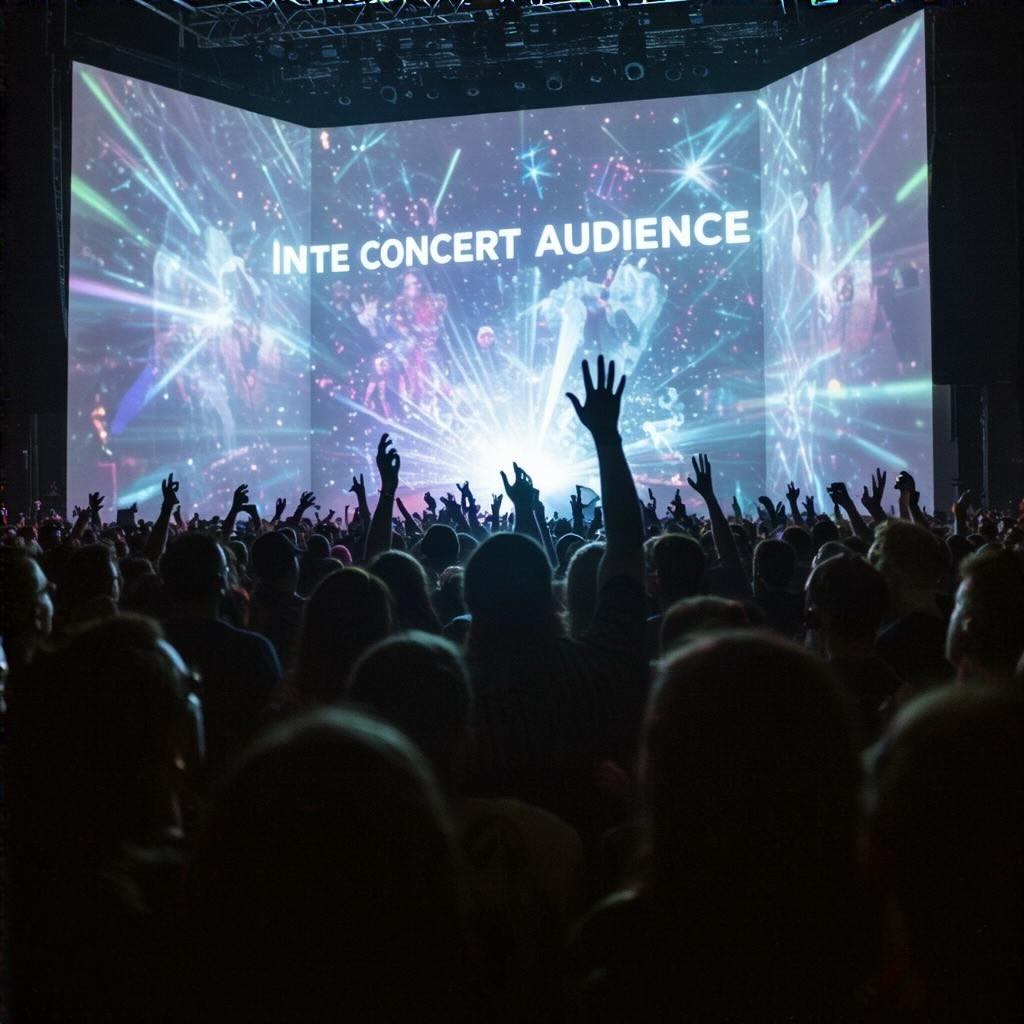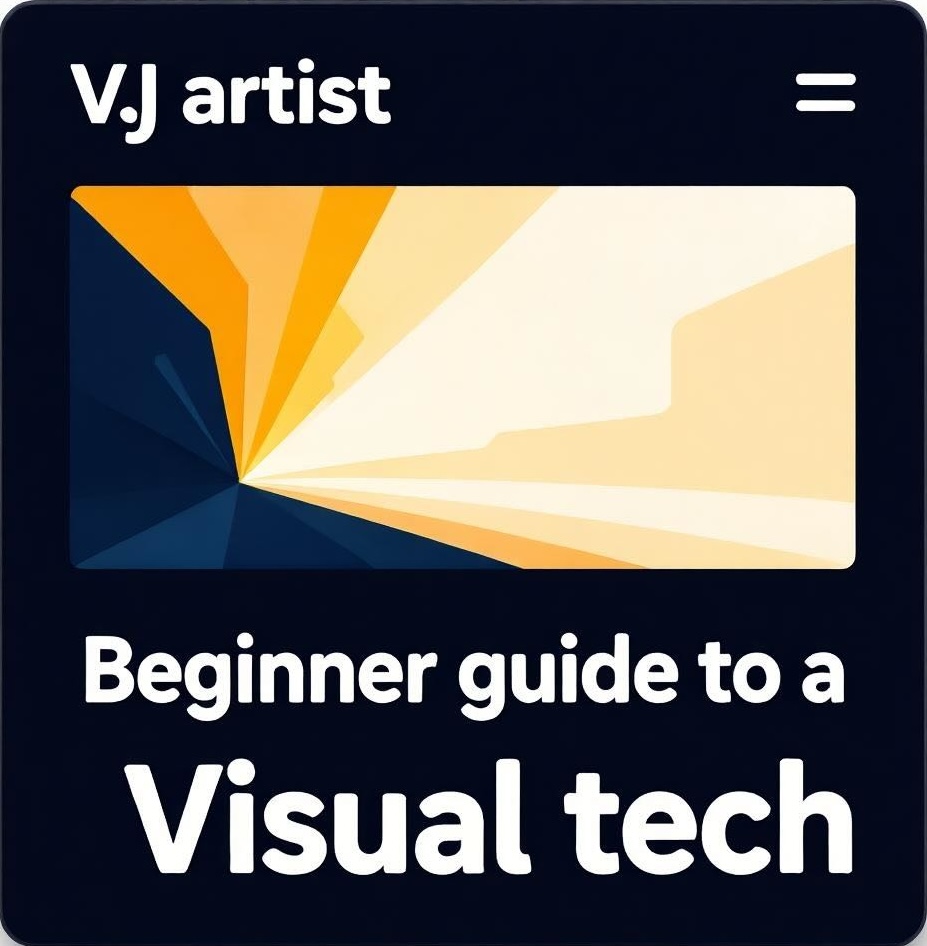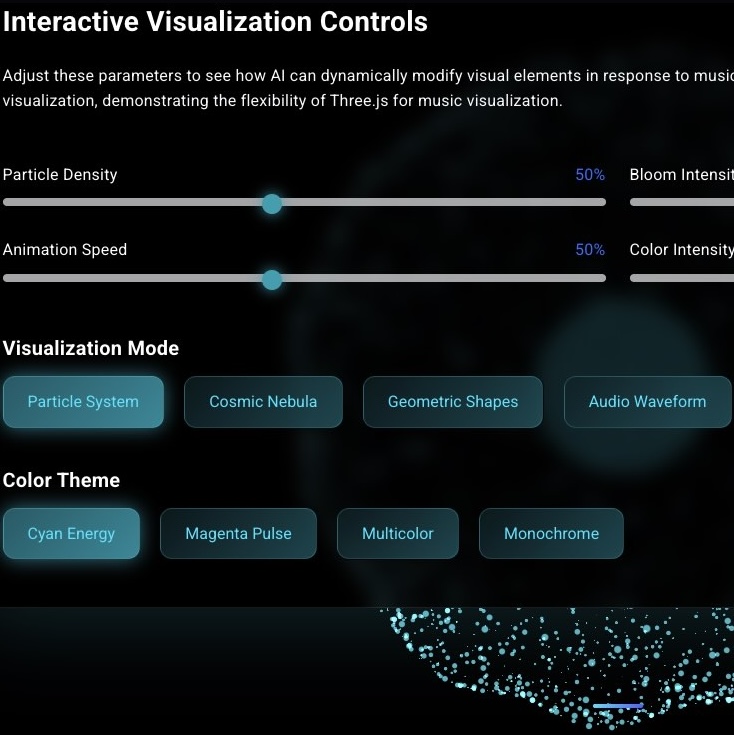
Next-generation AI visual effects at a live concert
A New Era in Concert Experiences
Artificial intelligence is fundamentally changing how visual content is created, presented, and experienced at live events. What was once a static visual presentation has evolved into dynamic, responsive, and emotionally intelligent visual displays that adapt to the music, audience reactions, and the environment in real-time.
This shift represents more than just a technological advancement—it's a transformation in how we experience and connect with live performances, creating multi-sensory experiences that were previously impossible.
Explore AI TechnologiesRevolutionary Changes in Concert Visuals
Real-Time Content Generation
AI systems can now generate visual content on-the-fly, responding to music beats, lyrics, and mood changes without pre-programming every element.
This enables truly unique performances where each show becomes a one-of-a-kind experience that can never be exactly replicated.
Music-Visual Synchronization
Advanced AI algorithms analyze music in real-time to create perfect synchronization between audio and visuals, highlighting emotional crescendos and subtle musical shifts.
This tight integration creates a unified sensory experience that amplifies the emotional impact of performances.
Audience-Responsive Systems
Modern AI visual systems can now monitor audience reactions, energy levels, and even emotional states to adapt content in real-time.
This creates a feedback loop where the audience becomes an active participant in creating the visual experience, rather than passive observers.
Before & After AI: The Visual Revolution
Traditional Visual Production
- Pre-rendered video content with fixed timelines
- Manual triggers for visual changes by VJs
- Limited adaptability during performances
- Identical visuals for every performance
- High production costs for quality content
- Lengthy production timelines
AI-Powered Visual Systems
- Real-time generated content that evolves dynamically
- Automatic synchronization with music
- Adaptive responses to performer and audience
- Unique visuals for each performance
- Reduced costs through automation
- Rapid iteration and deployment

Audience interaction with AI-generated visuals
Democratizing Visual Production
One of the most profound impacts of AI in concert visuals is the democratization of high-quality visual production. What once required large teams, expensive equipment, and months of preparation can now be achieved with sophisticated AI tools, more accessible hardware, and significantly reduced timelines.
This accessibility is enabling indie artists, smaller venues, and emerging creators to deliver visual experiences that can compete with major productions, leveling the playing field and fostering innovation across the industry.
Resources for MusiciansCase Studies: AI Transformation
The Virtual Orchestra
The London Symphony Orchestra partnered with AI visual artists to create a responsive backdrop that generated visual interpretations of the musical scores in real-time. Each instrument's contribution was visually represented through AI-generated patterns that evolved with the performance.
The result was a synesthetic experience where audience members could "see" the music being performed, adding an entirely new dimension to classical performances.
Interactive Festival Environments
The Glastonbury Festival implemented an AI-powered stage that analyzed crowd density, movement patterns, and energy levels to create responsive visual environments that adapted to the audience's collective state.
During high-energy performances, the system would intensify visual elements, while during more ambient moments, it would create calming, expansive visual landscapes. This created a sense of collective contribution to the experience.
Indie Artist Revolution
Independent artist Maya Lin used Compeller.ai's AI visual system to create stadium-worthy visuals for her club tour on a limited budget. The system analyzed her music in real-time and generated dynamic visuals that responded to her performance.
This allowed her to compete visually with major label acts despite having a fraction of their production budget, ultimately leading to viral success and a larger following.
Adaptive Touring Production
World tour production company StageSync developed an AI system that could adapt visual content to different venue configurations automatically. The system would analyze the venue's dimensions, projection surfaces, and lighting capabilities to optimize the visual experience for each unique space.
This eliminated the need for manual reconfiguration at each venue and ensured consistent quality across diverse performance spaces worldwide.
The Future is Here
AI-powered visual systems are no longer futuristic concepts—they're transforming live entertainment today. Discover how Compeller.ai can help you implement these revolutionary technologies in your next production.
Frequently Asked Questions
The hardware requirements for AI-powered visuals vary based on complexity and scale. Small to medium productions can now run sophisticated AI visual systems on high-end consumer GPUs, while larger productions might utilize distributed cloud rendering or dedicated GPU clusters. Many modern solutions like Compeller.ai offer scalable options that can adapt to different hardware configurations and venue sizes.
Key components typically include:
- Graphics processing units (GPUs) for real-time rendering
- Input devices for capturing audio and audience data
- High-speed networking infrastructure
- Quality projection or LED display systems
For more specific requirements, consult the technical specifications page.
The level of technical expertise required has decreased significantly as AI visual platforms have matured. Many systems now offer user-friendly interfaces that allow creative professionals to implement sophisticated visual effects without deep technical knowledge.
Entry-level solutions feature:
- Template-based approaches with customization options
- Intuitive drag-and-drop interfaces
- Preset configurations for common performance types
More advanced implementations might still require collaboration with technical specialists, but the barrier to entry continues to lower as the technology evolves. Our beginner's guide offers a roadmap for those new to AI visual production.
Yes, many AI visual systems are designed to integrate with industry-standard equipment and protocols. Most systems can work with:
- DMX lighting control systems
- Standard projection and video equipment
- Common sound reinforcement systems
- MIDI controllers and interfaces
This allows venues and production companies to gradually integrate AI capabilities without replacing their entire infrastructure all at once. However, for optimal performance, some hardware upgrades may be recommended. Consult our lighting systems integration guide for more details.
The cost structure for AI-powered visual production differs significantly from traditional approaches:
- Initial Investment: AI systems often require a higher upfront investment in technology and integration
- Ongoing Production: Once implemented, AI systems typically reduce ongoing costs by automating processes that would traditionally require extensive manual labor
- Scaling: AI solutions often scale more efficiently across multiple shows or venues
- Updates: Many AI platforms offer subscription models that provide ongoing updates and new capabilities
For smaller productions, the total cost of ownership can be significantly lower with AI solutions when averaged over multiple performances. Larger productions benefit from reduced personnel needs and faster iteration cycles. See our event organizer resources for detailed cost comparisons.
Related Resources

Beginners Guide to AI Visuals
Start your journey with AI concert visuals through our comprehensive guide for newcomers.
Read Guide
Three.js & AI Integration
Learn how to combine powerful web graphics with AI for browser-based visual experiences.
Explore Technology
Resources for Visual Artists
Discover tools, techniques and platforms for VJs and visual creators working with AI.
View Resources